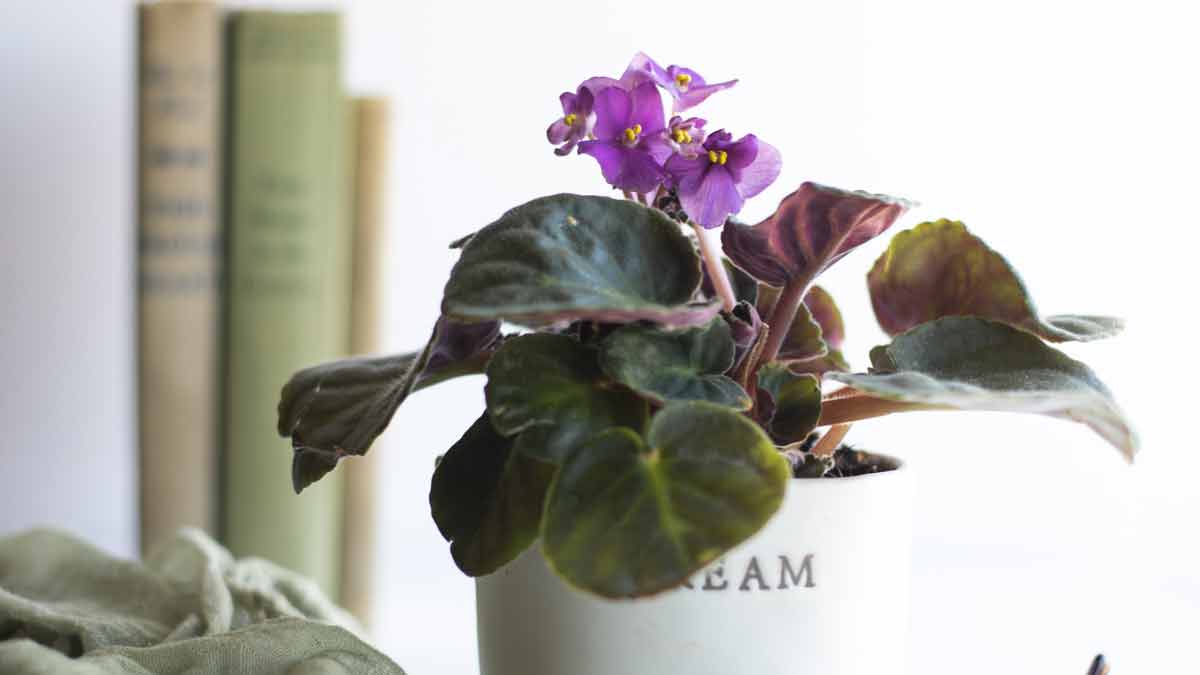African violets are one of the most popular houseplants. They are prized for their beautiful blooms and striking leaves.
But what do you do when you find your african violet leaves falling off?
There are several reasons why african violets drop their leaves. It’s essential to figure out the cause so that you can take steps to fix the problem.
This article will discuss the most common reasons for african violet leaves falling off and what you can do to fix the problem.
What Causes African Violet Leaves To Fall Off
There are several reasons why african violets drop their leaves.
The most common causes are:
1. Overwatering
Overwatering is one of the most common reasons for african violets to drop their leaves.
African violets need to be watered about once a week or when the soil is dry to the touch.
If you water your african violet too often, the roots will start to rot, and the leaves will fall off.
You also need to ensure that you’re not watering the leaves of the plant, as this can cause them to rot.
Water the soil around the plant, careful not to get water on the leaves.
2. Underwatering
Underwatering is another common reason for african violets to drop their leaves.
African violets need to be watered about once a week or when the soil is dry to the touch.
If you don’t water your plant enough, the african violet leaves will start to droop and then fall off.
The lack of water can also cause the leaves to turn yellow or brown.
You must ensure you’re watering your plant enough, especially during the hot summer months.
3. Too Much fertilizer
Too much fertilizer can also cause african violets to drop their leaves.
African violets need a balanced fertilizer that is high in phosphorus.
If you use too much fertilizer, the plant’s roots will be burned, and the leaves will fall off.
It’s best to use a diluted fertilizer and to only fertilize your plant every other week during the growing season.
4. Extreme Temperatures
African violets are tropical plants, and they prefer warm temperatures.
If the temperature drops below 60 degrees Fahrenheit, the african violet leaves will start to drop off.
The plant will also go into dormancy if the temperature drops too low.
If the temperature gets too high, above 85 degrees Fahrenheit, the leaves of the plant will start to turn brown and fall off.
You need to ensure that you keep your african violet plant in a room with a consistent temperature.
The ideal temperature for african violets is between 70 and 80 degrees Fahrenheit.
5. Not Enough Light
African violets need bright indirect light to thrive.
If your plant is not getting enough light, the african violet leaves will start to fall off.
You need to ensure you’re giving your plant enough light without putting it in direct sunlight.
The best place for an african violet is near a window that gets bright indirect light.
You can also use a grow light to give your plant the light it needs.
6. Too Much Sunlight
While african violets need bright light to thrive, too much sunlight will cause the leaves to fall off.
If you put your plant in direct sunlight, the leaves will start to turn brown and then fall off.
You need to ensure you’re giving your plant enough light without putting it in direct sunlight.
The best place for an african violet is near an east- or west-facing window, where it will get bright indirect sunlight.
You can also use a grow light to give your plant the light it needs.
7. Soil Issues
The type of soil you use can also cause african violets to drop their leaves.
African violets need well-draining soil that is high in organic matter.
If the soil is too dense, it will hold too much water, and the roots will rot.
If the soil doesn’t drain well, the roots will also rot.
You need to ensure that you’re using a well-draining soil high in organic matter, such as the African Violet potting mix.
8. Pests
Pests can also cause african violets to drop their leaves.
The most common pests are aphids, mealybugs, and spider mites.
Aphids are tiny green insects that suck the sap out of the leaves.
Mealybugs are tiny white insects that feed on the leaves and stems of the plant.
Spider mites are tiny spider-like creatures that spin webs on the leaves and suck the sap out of them.
Pests can cause african violets to drop their leaves by feeding on the plant.
They can also spread diseases that can cause the leaves to fall off.
You need to check your plant for pests regularly and treat them with a natural insecticide, such as neem oil.
9. Diseases
Diseases can also cause african violets to drop their leaves.
The most common are fungal diseases, such as root rot, powdery mildew, and leaf spot.
Fungal diseases are caused by fungi that live in the soil and on the plant’s leaves.
They can cause the leaves to turn yellow, brown, or black and then fall off.
You must remove any affected leaves and treat the plant with a fungicide.
10. Transplanting Stress
Transplanting can also cause african violets to drop their leaves.
When you transplant a plant, it goes through a lot of stress.
The roots are disturbed, and the plant has to adjust to a new environment.
This can cause the african violet leaves to fall off.
You need to make sure you’re transplanting your plant carefully and giving it time to adjust to its new environment.
11. Natural Leaf Drop
African violets naturally drop their leaves.
The plant will shed its oldest leaves to make room for new growth.
This is normal, and you don’t need to worry about it.
If you see a little leaf drop, it’s nothing to worry about.
However, seeing a lot of leaf drop could be a sign of a problem.
12. Winter Dormancy
African violets go through a period of dormancy in the winter.
The plant will stop growing during this time, and the leaves will fall off.
This is normal, and you don’t need to worry about it.
The plant will start growing again in the spring.
What To Do When African Violet Leaves Fall Off
If you see african violet leaves falling off, it’s essential to figure out the cause.
Once you know the cause, you can take steps to fix the problem.
Here are some things you can do when african violet leaves fall off:
1. Check The Light
The first thing you need to do is check the light.
African violets need bright indirect light.
Ensure the plant is not in direct sunlight, which can scorch the leaves.
You also need to make sure that the plant is getting enough light.
If the plant isn’t getting enough light, it will start to drop its leaves.
You can move the plant to a brighter spot or add a grow light.
2. Check The Water
The next thing you need to do is check the water.
African violets need to be watered regularly, but they don’t like to sit in water.
Make sure that you’re not overwatering the plant.
If the plant sits in water, it will start to drop its leaves.
You can also check the drainage of the pot.
If the pot doesn’t have good drainage, the roots will rot, and the plant will drop its leaves.
3. Check The Soil
The next thing you need to do is check the soil.
African violets need a well-draining potting mix.
If the soil is too dense, it will hold water, and the roots will rot.
To improve drainage, you can add some perlite or vermiculite to the potting mix.
4. Check The Temperature
The next thing you need to do is check the temperature.
African violets like warm temperatures, around 70 degrees Fahrenheit.
If the temperature is too cold, the plant will go into dormancy, and the leaves will fall off.
You can move the plant to a warmer spot or add a heat mat.
5. Inspect The Plant
The next thing you need to do is inspect the plant.
Look for any pests or diseases.
If you see any pests, you need to remove them and treat the plant with a natural insecticide. Insecticidal soap and neem oil are two good options.
If you see any diseases, you need to remove the affected leaves and treat the plant with a fungicide. A natural fungicide like sulfur can be effective.
6. Transplant The Plant
You may need to transplant the plant if you’re still having problems.
Transplanting can be stressful for the plant, so do it carefully.
Dig up the plant and transfer it to a new pot with fresh potting mix.
Give the plant some time to adjust to its new environment.
7. Prune The Plant
You may need to prune the African violet plant if you’re still having problems.
Pruning can help the plant focus its energy on new growth.
Cut off any leaves that are yellow or brown.
You can also cut off any leggy african violet stems.
8. Fertilize The Plant
If you still have problems, you may need to fertilize the plant.
African violets need to be fertilized every month during the growing season.
You can use a balanced fertilizer, or a fertilizer explicitly made for african violet plants.
What Are The Benefits Of African Violet Leaves Falling Off?
Although it may seem like a bad thing, there are some benefits to african violet leaves falling off.
First, it’s a way for the plant to get rid of old leaves.
Old leaves can be a source of pests and diseases, so getting rid of them can help the plant stay healthy.
Secondly, it can help the plant focus its energy on new growth.
When african violet leaves fall off, the plant has to put energy into growing new leaves.
This can help the plant stay strong and vigorous.
What To Do With African Violet Leaves That Have Fallen Off
If you find african violet leaves that have fallen off, you can pot them up and grow new plants.
To propagate african violets leaves, follow these steps:
- Take a fallen leaf and cut the petiole (the leaf stalk) about 1-2 inches from the base of the leaf.
- Place the leaf in a cup of water and wait for it to produce roots.
- Once the roots are about 2 inches long, you can pot up the leaf in some potting mix.
- Keep the soil moist and wait for the leaf to produce a new plant.
This process can take several weeks, so be patient.
Final Thoughts
If your African violet leaves are falling off, it could be due to various reasons. However, the most common culprits are too much water or not enough light.
Fortunately, both of these problems are relatively easy to fix. Adjust your watering and lighting accordingly, and your African violet should start to bounce back in no time.
If you’re still having trouble, you can try a few other things, such as fertilizing your plant or repotting it into fresh soil.
With a little trial and error, you should be able to get your African violet looking healthy and lush once again.







